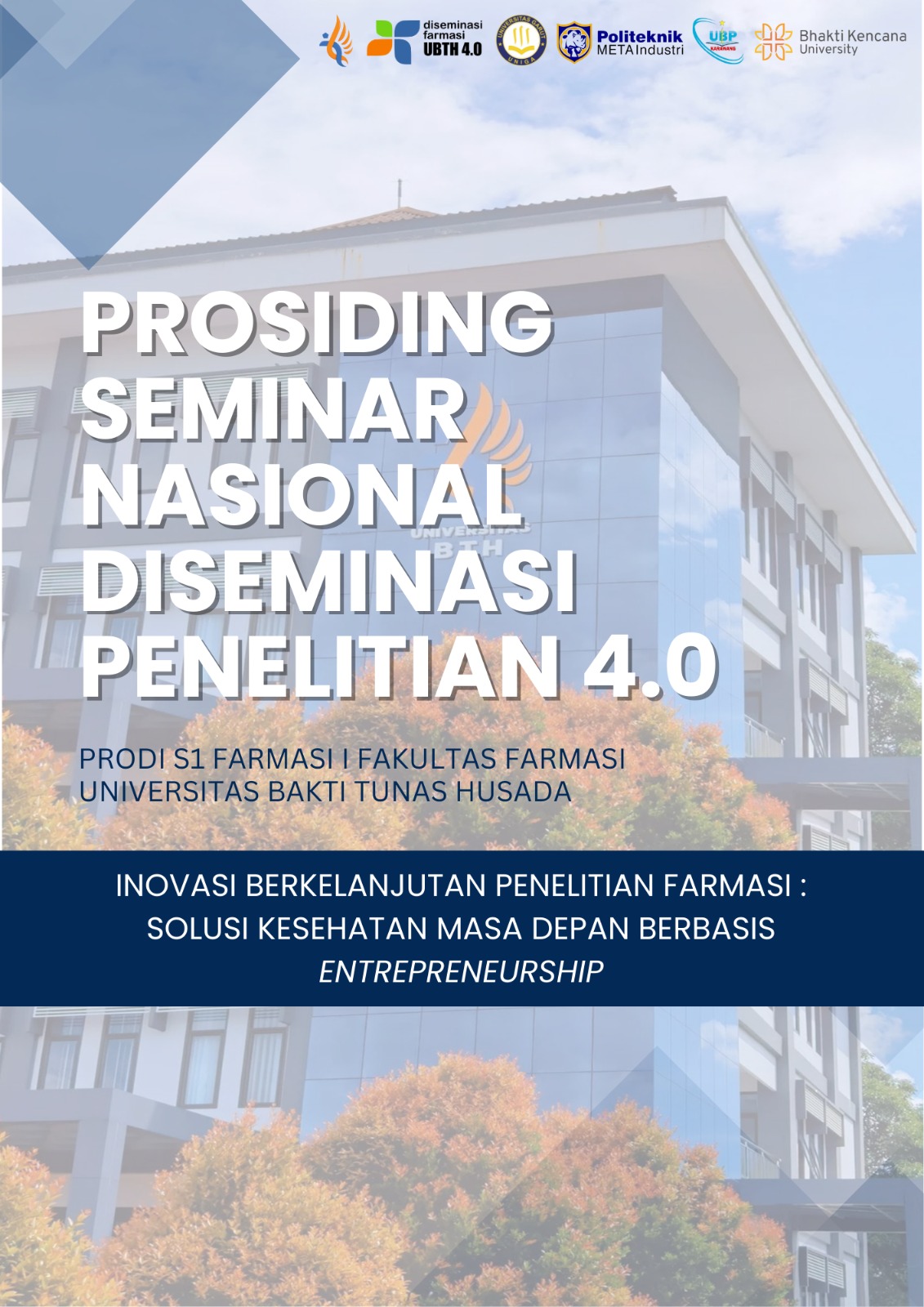Uji Aktivitas Antioksidan Cuka Kulit Buah naga Merah (Selenicereus monacanthus (Lem.) D.R.Hunt)
Keywords:
antioxidants, vinegar, fermentation, skin of red dragon fruitAbstract
The use of antioxidants can bolster the body's natural defense mechanism against free radical reactions. Because it contains anthocyanins, the red dragon fruit skin may have antioxidant properties. One technique to cultivate red dragon fruit peels is to make vinegar preparations since they are commonly discarded. Researching the antioxidant activity of the red dragon fruit peel acetic and skin juice, as well as evaluating its preparation, are the main goals of this study. In this RAL (Complete Random Design) experiment, two variables were controlled: the length of time the fermentation process lasted (7 or 10 days) and the concentration of the juice (F1, 50 mL, F2, 100 mL, and F3, 150 mL). In order to measure antioxidant activity, the Ferric Reducing Antioxidant Power (FRAP) method was employed. In terms of vinegar preparations, the results demonstrated that the red dragon peel juice had an IC50 value of 193.78 μg/mL, with the highest IC50 value of 16.39 μg/mL obtained in the F1 fermented for 7 days. There is an unpleasant odor, a somewhat brownish-pink tint, a pH value between 4.78 and 5.73, an alcohol level between 0.1% and 0.3%, an acetic acid content between 1.37 and 2.67%, and a total sugar content between 0.99 and 1.08% in the vinegar. This shows that red dragon fruit peel vinegar preparations have the potential as an antioxidant.
References
Al-kayyis, H. K., & Susanti, H. (2016). Perbandingan Metode Somogyi-Nelson Dan Anthrone-Sulfat Pada Penetapan Kadar Gula Pereduksi Dalam Umbi Cilembu (Ipomea batatas L.). Journal of Pharmaceutical Sciences and Community, 13(02), 81–89. https://doi.org/10.24071/jpsc.2016.13020 6
Handayani, V., Ahmad, A. R., Sudir, M., Etlingera, P., & Sm, R. M. (2014). Uji Aktivitas Antioksidan Ekstrak Metanol Bunga dan Daun Patikala ( Etlingera elatior ( Jack ) R . M . Sm ) Menggunakan Abstrak. Pharm Sci Res, 1(2), 86–93.
Hardoko, M. (2019). AKTIVITAS ANTIOKSIDAN DAN KARAKTERISTIK CUKA BUAH MANGROVE PEDADA
(Sonneratia alba). JFMR-Journal of Fisheries and Marine Research, 3(3), 322–330. https://doi.org/10.21776/ub.jfmr.2019.003.03.6
Ibroham, M. H., Jamilatun, S., & Kumalasari, I. D. (2022). A Review: Potensi Tumbuhan- Tumbuhan Di Indonesia Sebagai Antioksidan Alami. Jurnal UMJ, 1–13.
Leasa, H., & Matdoan, M. N. (2015). PENGARUH LAMA FERMENTASI TERHADAP TOTAL ASAM CUKA AREN (Arenga pinnata Merr.). BIOPENDIX: Jurnal Biologi, Pendidikan Dan Terapan, 1(2), 140–145. https://doi.org/10.30598/biopendixvol1issue2page140-145
Maesaroh, K., Kurnia, D., & Al Anshori, J. (2018). Perbandingan Metode Uji Aktivitas Antioksidan DPPH, FRAP dan FIC Terhadap Asam Askorbat, Asam Galat dan Kuersetin. Chimica et Natura Acta, 6(2), 93. https://doi.org/10.24198/cna.v6.n2.19049
Mangiri, B. S., Yani, S., & Anitasari, S. (2018). Sari Buah Naga Super merah (Hylocereus costaricensis) Sebagai Pewarna Alami
Plak Gigi. Jurnal Material Kedokteran Gigi, 7(1), 28. https://doi.org/10.32793/jmkg.v7i1.278
Nurismanto, R., Mulyani, T., & Ning, I. (2014). (Acetobacteracetii ). 8(2), 149–155.
Simanjuntak, E., & Feryawati, L. (2024). Katekin Daun Gambir ( Uncaria gambir roxb ) dapat Menurunkan Kadar MDA Serum Mencit Model Penuaan di Induksi oleh D-Galaktosa namun Menaikkan Ekspresi Relatif SOD2 di Hipokampus. 5(4), 249–255.
Sunardi, S. (2023). Analisis Gugus Fungsi Dan Penentuan Kadar Total Fenol Ekstrak Kulit Buah Naga Merah Dan Putih. Jurnal Redoks : Jurnal Pendidikan Kimia Dan Ilmu Kimia, 6(1), 8–18. https://doi.org/10.33627/re.v6i1.976
Teknologi, J., Pertanian, I., Teknologi, F., Unud, P., Jurusan, D., Industri, T., Teknologi, F., & Unud, P. (2016). 1 , 2 ,. 4(3), 71–84.
Theafelicia, Z., & Narsito Wulan, S. (2023). PERBANDINGAN BERBAGAI METODE PENGUJIAN AKTIVITAS ANTIOKSIDAN (DPPH, ABTS DAN FRAP) PADA TEH HITAM (Camellia sinensis). Jurnal Teknologi Pertanian, 24(1), 35–44. https://doi.org/10.21776/ub.jtp.2023.024. 01.4
Wahdaningsih, S. (2022). Uji Aktivitas Antioksidan Ekstrak Etanol dan Fraksi N- Heksan Kulit Buah Naga Merah (Hylocereus polyrhizus). Jurnal Pharmascience, 9(2), 176. https://doi.org/10.20527/jps.v9i2.13135
Werdhawati, A. (2014). Peran Antioksidan Untuk Kesehatan. Biotek Medisiana Indonesia, 3(1), 59–68.

